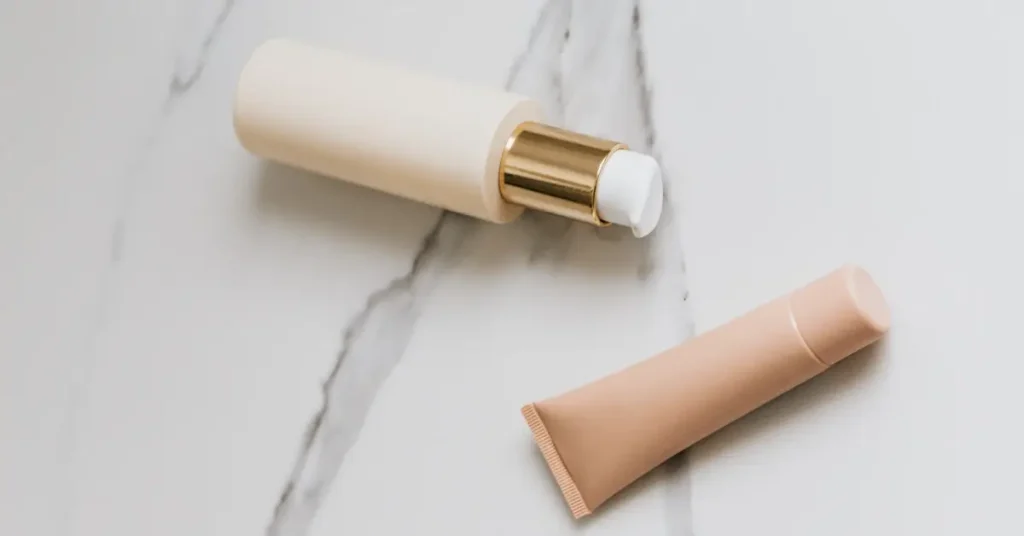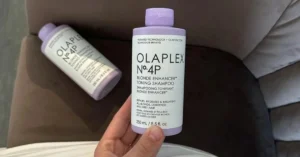Frustrated with ongoing acne and think you’ve tried every possible solution? You’re not alone. But, there’s great news ahead: I’ve discovered an incredible breakthrough that might change the way you fight acne.
Let me introduce you to the incredible power of salicylic acid and tea tree oil for acne-prone skin. These two natural ingredients have revolutionized my skincare routine, and I firmly believe they can work wonders for you too.
Table of Contents
Salicylic Acid and Tea Tree Oil
Imagine finally having the key to unlock clear, radiant skin. Salicylic acid is a game-changer when it comes to unclogging pores and reducing sebum levels, while tea tree oil has a remarkable ability to eliminate acne-causing bacteria.
These ingredients aren’t just empty promises – scientific research backs their effectiveness in not only preventing acne but also minimizing breakouts. And the best part? Salicylic acid and tea tree oil are gentle on your skin, making them suitable for all skin types.
Now that we’ve unveiled the potential benefits of these incredible ingredients, it’s crucial to learn how to use them effectively for maximum results. In the upcoming sections, we’ll delve into various techniques for incorporating salicylic acid and tea tree oil into your skincare routine.
Properties of Salicylic Acid

As someone who has struggled with acne, I know firsthand the powerful effects of salicylic acid and tea tree oil. In this section, let me walk you through the incredible benefits of salicylic acid, a commonly used ingredient in many skincare products.
Anti-Inflammatory Effects
One of the reasons I love salicylic acid is because of its impressive anti-inflammatory properties. When I had an inflamed pimple, applying a product containing salicylic acid helped reduce redness and irritation. You see, this acid has the unique ability to penetrate the skin’s oily layer and work its magic within the pores, making it an excellent choice to target inflamed blemishes.
Exfoliating Benefits
Let’s be honest – we all need a good exfoliating session now and then. Salicylic acid is a top-notch exfoliant due to its keratolytic effects. In other words, it helps to break down dead skin cells and prevent them from clogging the pores. For me, it was a game-changer in my skincare routine.
Pro tip: If you’re new to salicylic acid, start with using it once or twice a week to avoid over-exfoliating, which could lead to sensitivity or irritation.
Acne Treatment
Now, let’s talk about what makes salicylic acid an essential ingredient in fighting acne. Salicylic acid works like a charm as it not only unclogs pores and reduces inflammation, but it also helps regulate the skin’s natural oil production. During my personal battle with acne, this acid truly helped me gain clearer and healthier skin.
To maximize the benefits of salicylic acid, I suggest using it alongside tea tree oil, which has its own set of amazing acne-fighting properties. Combining these two powerful ingredients will give you the best shot at combating acne for good!
Remember to stay committed, patient, and above all, friendly to your skin while working towards a blemish-free complexion
Properties of Tea Tree Oil

Did you know that salicylic acid and tea tree oil can be a game-changer for your skincare routine? To better understand this dynamic duo, let me give you an overview of the incredible properties of tea tree oil.
Antibacterial Properties
As someone who has dealt with acne for years, I can attest to the fact that tea tree oil has helped me immensely due to its antibacterial properties. It is widely known for its ability to fight bacteria and reduce inflammation, making it perfect for tackling pesky pimples and calming my skin.
Antifungal Effects
But that’s not all! Tea tree oil is also highly effective against fungal infections. I’ve personally experienced its soothing effects when using it to treat athlete’s foot. The antifungal properties in tea tree oil can combat fungi like Candida and even help with stubborn dandruff issues.
Uses in Skincare
With tea tree oil’s numerous benefits, it has naturally become a key ingredient in my skincare regimen. Here are some pro tips on how to maximize its effects:
- Spot treatment: Apply a diluted mixture of tea tree oil and carrier oil directly to acne spots to reap the antibacterial benefits.
- Face wash: I enjoy adding a few drops of tea tree oil to my daily facial cleanser, giving it an extra antibacterial boost.
- Shampoo: Mix tea tree oil with your shampoo to address dandruff and promote a healthy scalp.
From personal experience, this versatile oil has truly made a difference in achieving healthier skin and hair. So, if you’re searching for a natural solution to your skin concerns, consider giving tea tree oil a try. I’m confident you’ll appreciate its friendly and effective approach!
Comparing Salicylic Acid and Tea Tree Oil

As someone always on the lookout for effective skincare solutions, I recently stumbled upon the dynamic duo of salicylic acid and tea tree oil. This powerful combination can be a game-changer for acne-fighting and overall skincare. Let’s dive into comparing their effectiveness for different skin concerns and potential side effects.
Effectiveness for Different Skin Concerns
Salicylic acid excels at unclogging pores and reducing sebum, making it especially effective for acne-prone and oily skin. On the other hand, tea tree oil is known for its antibacterial properties that help kill acne-causing bacteria.
Research indicates that tea tree oil is about as effective as benzoyl peroxide or salicylic acid in the treatment of acne, although it might work at a slower pace.
| Skincare Concern | Salicylic Acid | Tea Tree Oil |
|---|---|---|
| Acne | ✔️ | ✔️ |
| Oily Skin | ✔️ | |
| Antibacterial | ✔️ |
Potential Side Effects
While both salicylic acid and tea tree oil offer benefits for various skin concerns, it’s essential to consider the potential side effects. Salicylic acid, if used in high concentrations or excessively, may cause skin irritation, dryness, and peeling. Sensitive skin types should take extra care when using salicylic acid.
Tea tree oil, being a natural and gentle treatment, is less likely to irritate the skin than its pharmaceutical counterparts. However, it’s still important to use it properly – undiluted tea tree oil can cause skin irritation, itching, and redness. Always use diluted tea tree oil, and be sure to do a patch test before incorporating it into your routine.
To wrap up, both salicylic acid and tea tree oil can be beneficial for different skin concerns. By considering their unique properties and potential side effects, you can choose the best option to take care of your skin.
Combining Salicylic Acid and Tea Tree Oil
It contains 0.5% Salicylic Acid and Tea Tree Oil. Salicylic Acid is a chemical exfoliant that cleans out pores from deep within. Tea Tree has anti-septic and anti-bacterial qualities. Together they help reduce breakouts and excess sebum. It’s gentle enough for all skin types. pic.twitter.com/DhjM9lC1cE
— Hayley ⚡️ (@sehvain) October 5, 2019
Ever struggled with acne and wondered if there’s a magic solution? I’ve found the duo that might just have the answer: salicylic acid and tea tree oil. This powerful combination could be the game-changer your skin is craving.
Benefits of Combination
Salicylic acid is a versatile agent that not only unclogs pores, but also reduces sebum, helping to keep acne at bay. On the other hand, tea tree oil is a natural, gentle treatment with thorough antibacterial properties that efficiently kill acne-causing bacteria.
When using these two together, they work synergistically to target acne in a multi-faceted manner. Research suggests that the duo can be as effective as benzoyl peroxide or salicylic acid alone, but with less irritation and side effects.
Precautions and Tips

While the benefits of salicylic acid and tea tree oil are impressive, it’s important to exercise caution. Remember these tips to ensure maximum efficiency and safety:
- Dilution: Don’t apply tea tree oil directly to your skin – always dilute it to avoid irritation. Mixing it with a non-comedogenic carrier oil like jojoba oil is a good choice.
- Spot testing: As with any new skincare product, remember to conduct a patch test before applying it to your entire face. This is especially important for those with sensitive or allergy-prone skin.
- Seek medical advice: If you’re using additional acne treatments, be sure to consult a dermatologist or healthcare professional to prevent potential conflicts or excessive irritation
Remember, achieving clear and blemish-free skin is a journey that requires patience and persistence, but this duo might just become your new holy grail!
How to Use Salicylic Acid and Tea Tree Oil Together: Step by Step
I recently discovered the incredible combo of salicylic acid and tea tree oil to combat my acne. This powerful duo helps to unclog pores and zap those pesky blemishes, leaving my skin feeling refreshed and smooth. Here’s my step-by-step guide on how to use salicylic acid and tea tree oil together.
Step 1: Cleanse your face. Start by washing your face with a gentle cleanser to remove dirt and oil. This will help the salicylic acid and tea tree oil to penetrate more effectively.
Step 2: Apply salicylic acid. Apply a small amount of salicylic acid to your entire face, focusing on areas with active breakouts or clogged pores. Allow it to absorb for a few minutes.
Pro tip: A thin layer is enough! Too much can cause dryness or irritation.
Step 3: Dilute tea tree oil. Tea tree oil can be potent, so it’s crucial to dilute it with a carrier oil. Mix a few drops of tea tree oil with about a teaspoon of carrier oil such as jojoba, argan, or even water-based hydrating serum. Avoid using carrier oils like coconut or olive oil, as they can clog your pores! Womenshealthmag recommends avoiding carrier oils that can exacerbate acne.
Step 4: Apply the mixture. Using a cotton bud, apply the diluted tea tree oil mixture to your active pimples or acne-prone areas. Let it absorb for a few minutes. Be cautious not to apply too much tea tree oil, as it can be irritant.
Step 5: Moisturize. Finish your routine by applying a lightweight, non-comedogenic moisturizer to hydrate your skin and lock in the active ingredients.
In my experience, using salicylic acid and tea tree oil together has significantly improved the condition of my skin. Just remember that consistency is key – stick to this routine regularly, and you’ll likely see results, too.
FAQ

What not to mix with tea tree oil for acne?
Tea tree oil should not be mixed with benzoyl peroxide or other acne medications, as it may cause skin irritation and dryness.
How often should you put tea tree oil on a pimple?
According to skin care experts, tea tree oil should be applied twice daily for six to 12 weeks to start seeing a benefit. However, it should not be applied directly to the skin and should be diluted with a carrier oil like jojoba oil.
How many days does it take for tea tree oil to work on acne?
The effectiveness of tea tree oil on acne can vary. Some individuals may see improvements within a few days, while others may take several weeks. Consistent use for at least six to 12 weeks is often recommended to assess its full potential.
When should I stop using tea tree oil?
If you experience any severe skin irritation, allergic reactions, or worsening of your acne after using tea tree oil, it is advisable to discontinue use and consult a dermatologist. Additionally, if there is no improvement after several weeks of consistent use, it may be worth exploring alternative treatments.
What carrier oils can I mix with tea tree oil for acne?
Some suitable carrier oils to mix with tea tree oil for acne include jojoba oil, coconut oil, grapeseed oil, almond oil, and olive oil. These oils help dilute tea tree oil and provide additional benefits for the skin.
Can I leave tea tree oil on my face overnight?
It is generally safe to leave diluted tea tree oil on the face overnight. However, it’s essential to start with a small amount and observe your skin’s reaction. If any irritation occurs, reduce the duration or discontinue overnight use.
If you liked this blog article about the question: Salicylic Acid and Tea Tree Oil: Skin Savior In 2023?, don’t forget to leave us a comment down below to tell us about your experience.






